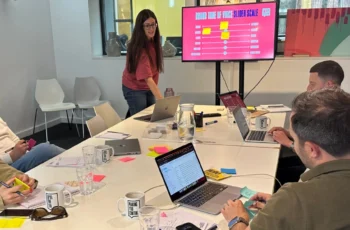Crafting Irresistible Content: The Power Of Personas

Trying to please everyone? Good luck with that! You know as well as we do that everyone is different, and what drives one person to love your brand might not work for someone else. It’s likely that your business serves a range of different customer segments – each with their own unique needs, goals, and expectations.
If you want to make sure your blogs, web content, and email campaigns really hit the mark, it’s a good idea to break down your audience into a few key target markets. Wondering where to start? We’ve got you…
Unmasking your audience
To begin with, take a moment to consider who’s purchasing your products or services and why. Do you sell direct to the consumer, or do you also work with businesses and resellers? Can you drill down further into distinct demographics – like age, location, profession, or income bracket?
Armed with these insights, develop 2-5 personas that represent your customers. Think about what they want in relation to your business. This will give you a clear picture of just how diverse your audiences can be. For example, a low-income family in a rural area will have completely different priorities in comparison to a young professional navigating the hustle and bustle of London.
Here’s an example persona for inspiration…
Meet Sarah Thompson, The Ambitious Marketing Executive
|
Finding the winning format
So, you’ve nailed down your user personas. Nice work! Now it’s time to talk about how your audiences like to engage with you. You know how it goes: Gen Z are on YouTube and TikTok, while millennials can be found on Instagram and Twitter. The professional crowd, on the other hand, gravitates towards LinkedIn and email marketing – while executives have a soft spot for good old-fashioned print. But as they say, the devil’s in the details. Within these groups, other distinctions may apply…
Picture this: a builder and a project manager walk into a blog. Who’s more likely to read it? Who is regularly refreshing their email inbox? What interests do these individuals share, and what sets them apart?
Likewise, you may have a split in your audience’s level of understanding. Guides and whitepapers could be great if you are, say, an IT support company warning regular customers about cybersecurity. But for your B2B clients who already have some technical knowledge, mixing things up with some quick-fire news updates might be the way to go.
Here’s how we might add detail on preferred formats to our example persona…
Touchpoints: With a packed schedule, Sarah prefers quick and digestible content in the form of social posts, blogs, and targeted emails. She seeks actionable advice to improve her marketing strategies, as well as content on leadership and personal development, across the following channels:
|
See how tapping into Sarah’s unique needs, preferences, and motivations has the potential to transform your content strategy?
Reaching the right people
Now you’ve got all these profiles and their preferred platforms, let’s focus on the content they crave. Your final hurdle is figuring out what your audience actually wants to read in their chosen formats.
This might mean doing some extra research, chatting to people in each demographic and analysing other relevant content in their particular sector. Which topics keep popping up over and over again? How can you touch on goals, frustrations, and motivations by weaving these into your own marketing? These are the key elements of copywriting that will anchor your strategy while unlocking new doors to fresh, thought-provoking material.
Want to make an impact?
If you don’t segment your audience, you run the risk of losing one group while trying to please another. You don’t have to settle for that – you can have them all hanging on your every word (literally).
To guarantee you’re maximising brand engagement, let’s level up your content marketing game. Get in touch to see how a strategic approach can help things like social media, emails, and web content truly resonate with your audience.




